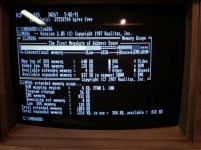This all can get confusing, particularly with RAM being supplied from multiple sources.
One thing you need to get down pat is the definitions:
Conventional (IBM's early term is 'base'):
The amount of RAM fitted between addresses 0 and 640 KB. Can come from multiple sources. In my main IBM 5170, the motherboard supplies from 0 to 512 KB, and I have a dedicated RAM card that supplies 128 KB between addresses 512 KB and 640 KB. So I have 640 KB of conventional memory.
Extended (IBM's early term is 'expansion'):
RAM past the 1 MB address. In the diagram [
here] (not your InBoard by the way), there is 4 MB of extended memory. If you have multiple cards providing extended memory, there must be no gaps between that memory. Where one card finishes supplying extended memory, you configure another card to start its extended memory at that address.
Expanded memory:
Defined on WikiPedia. Not the same as 'expansion'. An important point for you is that the 5170's SETUP does not care about expanded memory. You do not need to enter that figure.
Unfortunately, Intel are confusing the matter. The 1 MB of RAM on the InBoard 386 card is a 'pool' of RAM, available to be configured for various purposes. So, Intel should ideally be using the word 'pool' or something similar, but in the display put out by ILIM386, Intel has used "extended memory".
5170 SETUP
The base (conventional) and expansion (extended) figures that you put into the 5170's SETUP are to represent the amounts of base and expansion memory that the 5170's power on self test (POST) sees at power up time, before any software has loaded.
I have things to do now. I recommend that you remove the Above Board and get back to a working memory configuration using only the InBoard 386. From behaviour that you have described earlier, at power on, the 1 MB pool of RAM on the InBoard 386 card appears as 1 MB of extended memory only. Only later when the driver loads is the pool 'carved up' for other purposes. It would be really good if someone else can confirm that, because the behaviour differs to what I remember of some other Intel cards.
If it is the case that the 'carving up' happens after the driver is loaded, then what would go in the 5170's SETUP would be:
Base = 512 KB
Extended = 1024 KB
That would represent what the 5170's POST sees at power on.



